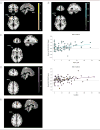Parsing dimensional vs diagnostic category-related patterns of reward circuitry function in behaviorally and emotionally dysregulated youth in the Longitudinal Assessment of Manic Symptoms study
- PMID: 24285346
- PMCID: PMC4238412
- DOI: 10.1001/jamapsychiatry.2013.2870
Parsing dimensional vs diagnostic category-related patterns of reward circuitry function in behaviorally and emotionally dysregulated youth in the Longitudinal Assessment of Manic Symptoms study
Abstract
Importance: Pediatric disorders characterized by behavioral and emotional dysregulation pose diagnostic and treatment challenges because of high comorbidity, suggesting that they may be better conceptualized dimensionally rather than categorically. Identifying neuroimaging measures associated with behavioral and emotional dysregulation in youth may inform understanding of underlying dimensional vs disorder-specific pathophysiologic features.
Objective: To identify, in a large cohort of behaviorally and emotionally dysregulated youth, neuroimaging measures that (1) are associated with behavioral and emotional dysregulation pathologic dimensions (behavioral and emotional dysregulation measured with the Parent General Behavior Inventory 10-Item Mania Scale [PGBI-10M], mania, depression, and anxiety) or (2) differentiate diagnostic categories (bipolar spectrum disorders, attention-deficit/hyperactivity disorder, anxiety, and disruptive behavior disorders).
Design, setting, and participants: A multisite neuroimaging study was conducted from February 1, 2011, to April 15, 2012, at 3 academic medical centers: University Hospitals Case Medical Center, Cincinnati Children's Hospital Medical Center, and University of Pittsburgh Medical Center. Participants included a referred sample of behaviorally and emotionally dysregulated youth from the Longitudinal Assessment of Manic Symptoms (LAMS) study (n = 85) and healthy youth (n = 20).
Main outcomes and measures: Region-of-interest analyses examined relationships among prefrontal-ventral striatal reward circuitry during a reward paradigm (win, loss, and control conditions), symptom dimensions, and diagnostic categories.
Results: Regardless of diagnosis, higher PGBI-10M scores were associated with greater left middle prefrontal cortical activity (r = 0.28) and anxiety with greater right dorsal anterior cingulate cortical (r = 0.27) activity to win. The 20 highest (t = 2.75) and 20 lowest (t = 2.42) PGBI-10M-scoring youth showed significantly greater left middle prefrontal cortical activity to win compared with 20 healthy youth. Disruptive behavior disorders were associated with lower left ventrolateral prefrontal cortex activity to win (t = 2.68) (all P < .05, corrected).
Conclusions and relevance: Greater PGBI-10M-related left middle prefrontal cortical activity and anxiety-related right dorsal anterior cingulate cortical activity to win may reflect heightened reward sensitivity and greater attention to reward in behaviorally and emotionally dysregulated youth regardless of diagnosis. Reduced left ventrolateral prefrontal cortex activity to win may reflect reward insensitivity in youth with disruptive behavior disorders. Despite a distinct reward-related neurophysiologic feature in disruptive behavior disorders, findings generally support a dimensional approach to studying neural mechanisms in behaviorally and emotionally dysregulated youth.
Figures



Comment in
-
Categories and dimensions, brain and behavior: the yins and yangs of psychopathology.JAMA Psychiatry. 2014 Jan;71(1):15-7. doi: 10.1001/jamapsychiatry.2013.2810. JAMA Psychiatry. 2014. PMID: 24285233 No abstract available.
References
-
- Leibenluft E, Charney DS, Pine DS. Researching the pathophysiology of pediatric bipolar disorder. Biological Psychiatry. 2003;53(11):1009–20. - PubMed
-
- Abela JRZ, Hankin BL. Handbook of depression in children and adolescents. Guilford Press; 2007.
-
- Barkley R. Deficient emotional self-regulation: a core component of attention-deficit/hyperactivity disorder. J ADHD Relat Disord. 2010;1(2):5–37.
-
- Maedgen JW, Carlson CL. Social functioning and emotional regulation in the attention deficit hyperactivity disorder subtypes. Journal of Clinical Child Psychology. 2000;29(1):30–42. - PubMed
Publication types
MeSH terms
Grants and funding
- K01 MH092603/MH/NIMH NIH HHS/United States
- UL1 TR000005/TR/NCATS NIH HHS/United States
- R01 MH073953/MH/NIMH NIH HHS/United States
- 2R01 MH73967-06A1/MH/NIMH NIH HHS/United States
- 2R01 MH73816-06A1/MH/NIMH NIH HHS/United States
- 2R01 MH73801-06A1/MH/NIMH NIH HHS/United States
- K23 MH097889/MH/NIMH NIH HHS/United States
- R01 MH073816/MH/NIMH NIH HHS/United States
- K01 MH094467/MH/NIMH NIH HHS/United States
- R01 MH073967/MH/NIMH NIH HHS/United States
- 2R01 MH73953-06A1/MH/NIMH NIH HHS/United States
- R01 MH073801/MH/NIMH NIH HHS/United States
- P30 MH090322/MH/NIMH NIH HHS/United States
LinkOut - more resources
Full Text Sources
Other Literature Sources
Medical
Miscellaneous

